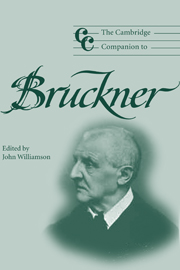Book contents
- Frontmatter
- Part I Background
- Part II Choral music
- Part III The symphonist
- 7 The Brucknerian symphony: an overview
- 8 Bruckner's symphonies – a reinterpretation: the dialectic of darkness and light
- 9 Programme symphony and absolute music
- 10 Bruckner editions: the revolution revisited
- 11 Bruckner and the symphony orchestra
- 12 Between formlessness and formality: aspects of Bruckner's approach to symphonic form
- 13 Formal process as spiritual progress: the symphonic slow movements
- 14 Bruckner and harmony
- Part IV Reception
- Notes
- Select bibliography
- Index
10 - Bruckner editions: the revolution revisited
from Part III - The symphonist
Published online by Cambridge University Press: 28 September 2011
- Frontmatter
- Part I Background
- Part II Choral music
- Part III The symphonist
- 7 The Brucknerian symphony: an overview
- 8 Bruckner's symphonies – a reinterpretation: the dialectic of darkness and light
- 9 Programme symphony and absolute music
- 10 Bruckner editions: the revolution revisited
- 11 Bruckner and the symphony orchestra
- 12 Between formlessness and formality: aspects of Bruckner's approach to symphonic form
- 13 Formal process as spiritual progress: the symphonic slow movements
- 14 Bruckner and harmony
- Part IV Reception
- Notes
- Select bibliography
- Index
Summary
Textual matters loom large with Bruckner. Not only have they been considered and reconsidered by generations of Bruckner scholars, but anyone, professional, student, or amateur, approaching this repertory soon runs into the ‘Bruckner problem’. Put simply, many of Bruckner's works exist in multiple versions and editions, some of which are clearly authentic, some of which are now known to be not authentic, and some of which are of unclear or disputed authenticity. The existence of multiple versions of Bruckner's symphonies goes back to the composer's time; as is well known, he prepared more than one version of several of his works and the published texts of most of his works deviate in some way or another from his manuscript scores.
Currently the study and performance of Bruckner's works are ordinarily based on a fairly well-defined canon of versions drawn from the Bruckner Gesamtausgabe, the now nearly complete critical edition of Bruckner's works primarily edited by Leopold Nowak. For several symphonies, notably the Second, Fourth, Seventh, and Eighth, some conductors and critics prefer the somewhat different scores edited by Robert Haas, who directed the first collected edition in the 1930s and 1940s. Nowak's and Haas' scores alike are based principally on Bruckner's autograph manuscript scores and, with a few exceptions – most importantly, Haas' editions of the Second and Eighth Symphonies – are examples of sound editorial methodology.
- Type
- Chapter
- Information
- The Cambridge Companion to Bruckner , pp. 121 - 137Publisher: Cambridge University PressPrint publication year: 2004
- 2
- Cited by



